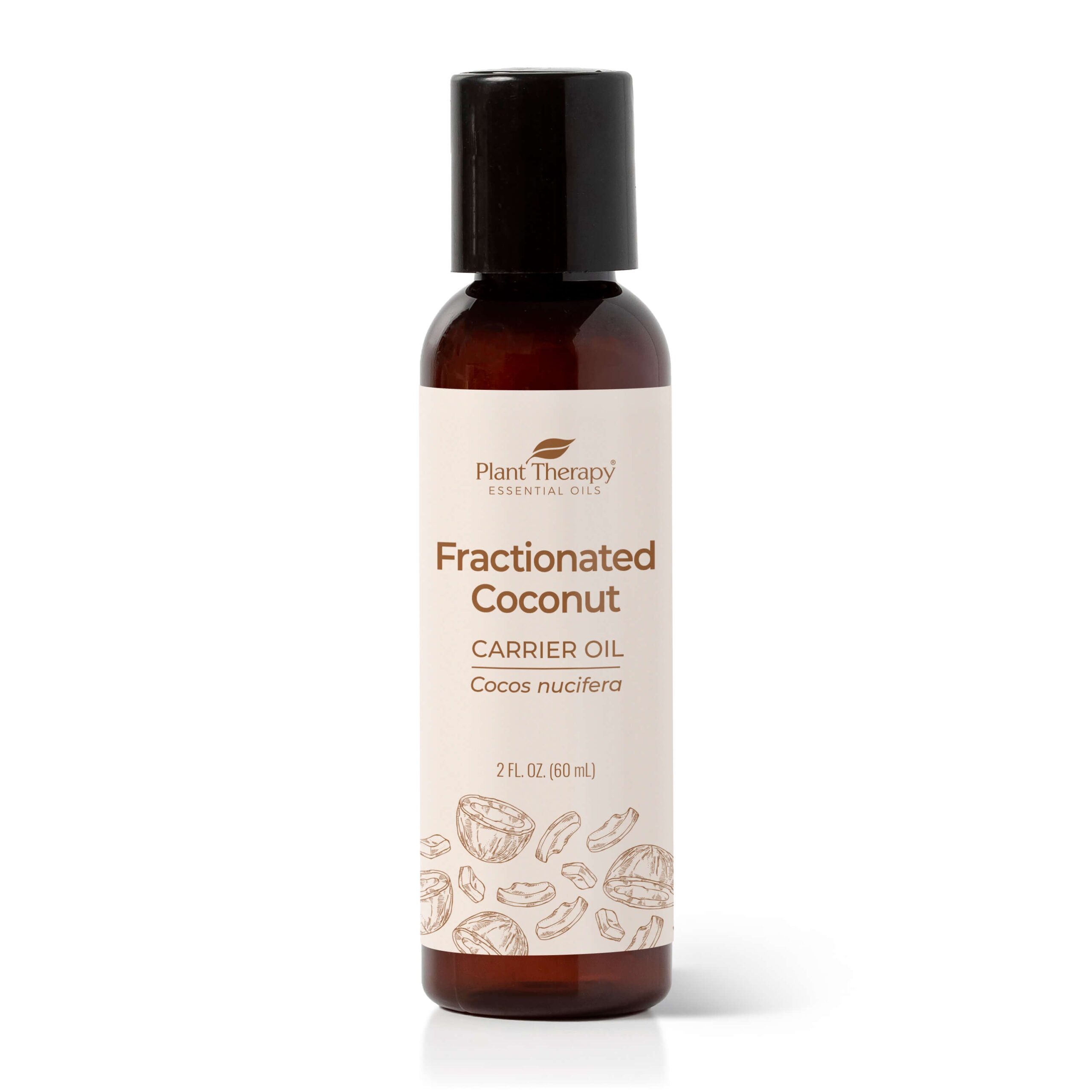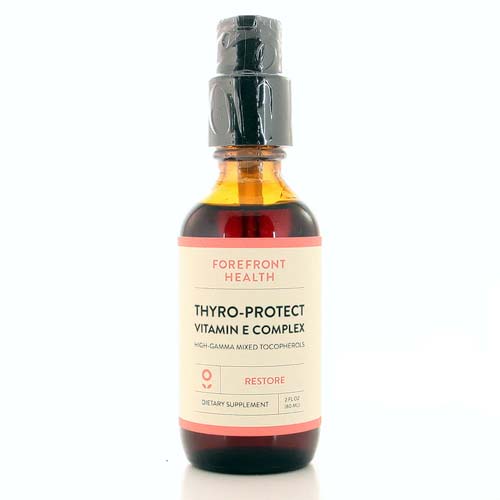Learn how to make DIY tanning oil for a natural, sun-kissed glow fast! Skip the baby oil or chemical-laden bronzing lotions filled with ingredients that can further damage your skin. This all natural tanning oil recipe contains low-PUFA carrier oils, sun-protective antioxidants, and a tanning accelerator to help you achieve a healthy, glowing tan in less time.
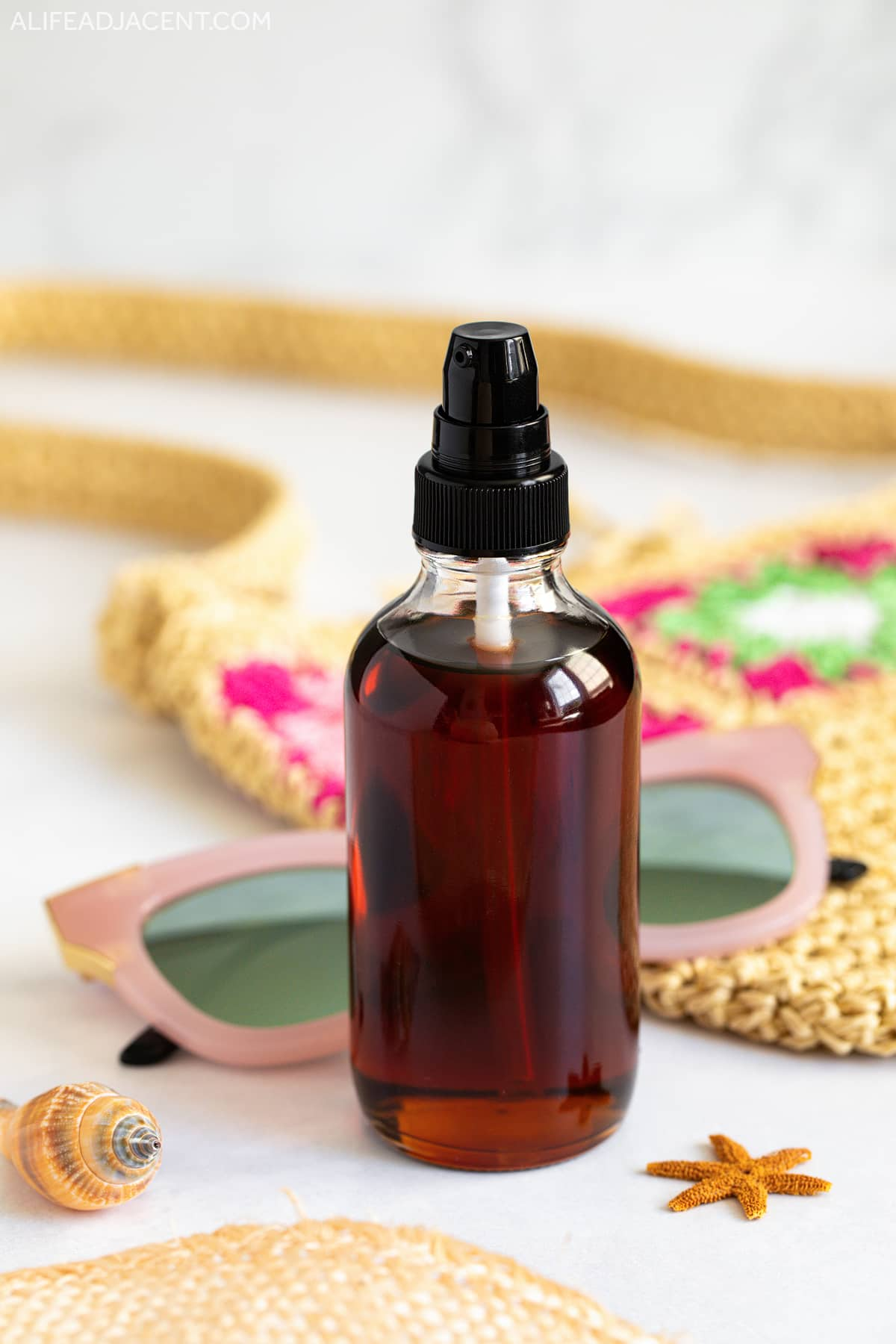
I cringe when I read the ingredients label on a bottle of “dark tanning oil” – synthetic fragrance, chemical sunscreen filters, and mineral oil. Not to mention, many of the most popular suntan oils on the market also contain skin-aging polyunsaturated oils.
We all know tanning comes with risks. But why make it even more damaging by using potentially harmful products on your skin?
As for homemade tanning hacks, there’s a lot of questionable advice online. The popular baby oil and iodine trick is a recipe for skin damage, and unfortunately, many tanning oil DIYs contain ingredients such as essential oils, which can harm your skin when exposed to direct sunlight.
The way I see it, if I’m going to tan, I want to avoid using harmful ingredients – and that’s why I made this homemade tanning oil.
Natural tanning oil for a sun-kissed glow
This easy, coffee-infused DIY tanning oil helps you achieve a darker tan fast while protecting and moisturizing dry skin. It contains antioxidants that may help mitigate skin damage, and its natural color gives you an instant bronzed glow while you wait for the real tan to kick in.
I spent a summer sifting through tanning studies in an effort to make the best natural tanning oil. So like all my beauty recipes, this tanning lotion is no-nonsense. It does not contain any fluffy, ineffective ingredients, and I will explain exactly why each one works for tanning.
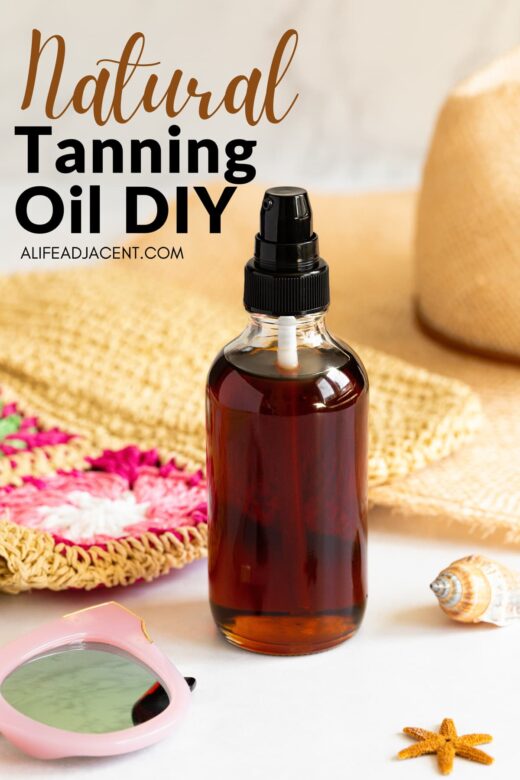
Before using or making this DIY to enhance your body bronzing routine, please note that it’s your responsibility to read the safety disclaimer at the end of this article.
If you’re not interested a long explanation of suntan oil ingredients or benefits, simply skip straight to the recipe. Finally, even if you don’t tan, this recipe makes a lovely, nourishing DIY coffee body oil.
- 🧡 Why I made this tanning oil DIY
- 🧴 What is tanning oil, and how does it work?
- ❓ What’s in a tanning oil?
- 💥 The problem with PUFAs in tanning oil
- 🥣 Ingredients + Supplies
- 📝 Tanning Oil Recipe
- 🥣 How to make tanning oil
- ☀️ Tanning Oil Ingredients + Benefits: Detailed Breakdown
- ⚠️ Tanning oil safety disclaimer
Why I made this DIY tanning oil
For me, part of living a lifestyle in tune with nature involves getting regular sun exposure for health and well-being. That’s why sometimes I opt to get a summer glow the natural way, bundled with vitamin D and the sun’s vital life force energy.
Of course, there’s no denying the dangers of excess tanning. But there’s no denying the beneficial effects of the sun1, either, which quite literally sustains life on Earth.
Clearly, the issue is not black and white, as our collective sun-phobia has led to an epidemic of low vitamin D levels2 and oceans filled with endocrine-disrupting chemical sunscreen filters3. Meanwhile, melanoma rates have continued to rise.

There’s also mounting evidence that spray tans, fake tans, and self-tanner may not be entirely “safe” tans after all. While the research is not yet conclusive, sunless tanners such as DHA and erythrulose may contribute to skin aging.4,5 Not to mention, they also interfere with vitamin D production6.
To be clear, I’m not suggesting tanning in the sun is completely safe, either. I use this DIY tanning oil for an occasional real tan, but I still use liquid bronzer, tanning drops and an organic self-tanner in my natural beauty routine.
What is tanning oil, and how does it work?
Tanning oil is applied to your skin before sun exposure to help encourage and accelerate the tanning process.
Its benefits include keeping your skin protected and moisturized under harsh, drying UV rays. It may also help you tan darker and faster outside, which means you need less time under damaging sunlight.
While there’s not a lot of scientific literature on exactly how it works, the general consensus seems to be that oil helps you tan by refracting light7. In other words, tanning oil absorbs sunlight and disperses it across the surface of your skin, increasing the intensity of UV rays.
But aside from making the sun’s rays stronger, it may also contain tanning accelerators or bronzing agents to further enhance darkening.
What’s in a tanning oil?
When you really break down the ingredients, making your own tanning oil at home is very simple. Most store-bought suntan oils are just mixtures of carrier oils to amplify UV rays, antioxidants to protect the skin, and possibly some tanning accelerators to stimulate melanin production.
Some notable bronzing agents include tyrosine, copper peptides, and melanin-stimulating peptides such as octapeptide-5, which promote a dark tan.
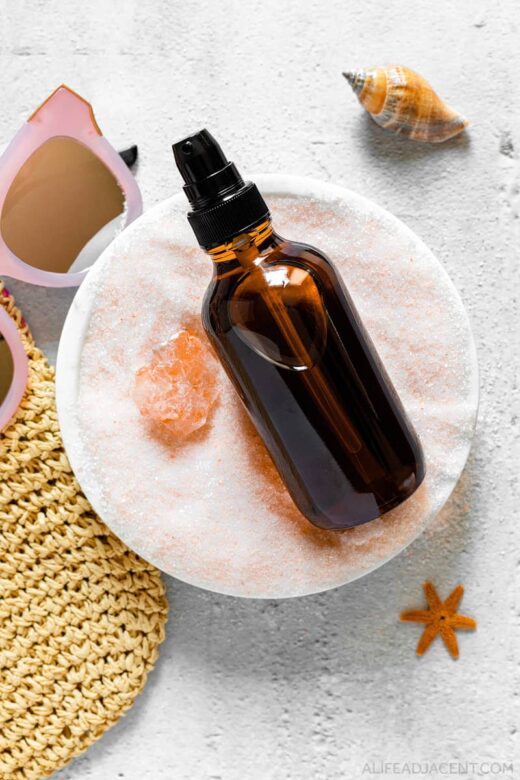
Carotenes such as beta carotene may also help promote a glowing, golden tan, which is why annatto and carrot oil are other popular tanning oil ingredients. But evidence suggests it’s best to consume carotene internally for tanning benefits8 (just another reason to eat your Ray Peat Carrot Salad).
Finally, bronzing oils may also contain added fragrance or color for aesthetic appeal, and chemical sunscreen filters for a small amount of SPF protection.
But besides the more obvious problems with synthetic fragrance, one of the main issues with store-bought tanning oils is that they are often high in polyunsaturated fatty acids (PUFAs). And if there is ever a time to be conscious of PUFAs, it’s when you’re baking in the sun.
The problem with PUFAs in tanning oil
In the same way you wouldn’t use your finest olive oil for high-heat frying, you want to be very careful with the oils you use for tanning.
Polyunsaturated fatty acids (PUFAs) are abundant in some of the most popular skincare carrier oils, including sunflower oil, safflower oil, sweet almond oil and even red raspberry seed oil, which is often said to have natural SPF properties (this is a myth, unfortunately).
These oils can really wreak havoc in a tanning oil, because PUFAs are highly unstable and prone to oxidation. They break down readily when exposed to sunlight, creating a cascade of free radicals that damages the skin9.
According to Dr. Ray Peat, sunlight directly interacts with PUFAs to cause sun damage10. As a result, slathering your body with unstable, high PUFA seed oils while tanning may cause even more skin damage than sun exposure alone.
Oxidized PUFAs also steal the skin’s antioxidants11, lowering its inherent defences against oxidative stress. And since sunburn occurs when the stress of UV rays overpowers the skin, oxidized PUFAs can also make you more likely to sunburn12.
This is a very brief summary, so for further reading on this subject, please see Dr. Ray Peat, Dr. Cate Shanahan, and my article on how polyunsaturated oils are aging your skin.
For now, the only thing you need to know is that saturated fats are the most stable fatty acids, which makes highly saturated oils (such as coconut oil) best for tanning.
Ingredients + Supplies
I’ve included two versions of this sun tanning oil: a simple, 3-ingredient recipe for those who don’t have many ingredients on hand, and a more complex full recipe for those who want to reap maximum benefits.
Many ingredients are optional and can easily be omitted, so you can also customize your suntan oil as needed.

You’ll need:
- Fractionated coconut oil: light, non-greasy, and fully saturated carrier oil
- Liquid lanolin oil: rich in natural cholesterol to promote vitamin D synthesis
- Roasted coffee oil: high in antioxidants to protect the skin (it’s also an instant DIY self tanner)
- Vitamin E: important antioxidant to help defend against sun damage
- Tetrahexyldecyl ascorbate (vitamin C): provides antioxidant protection and collagen support
- Vitamin D: stimulates melanin synthesis for a dark tan faster
The tutorial is below for those who are eager to get started with the DIY. If you’re interested, you can read an in-depth explanation of each ingredient and its benefits after the recipe.
Tanning Oil Recipe
DIY Tanning Oil
65g fractionated coconut oil or MCT oil
20g liquid lanolin or ultra-purified lanolin
10g coffee essential oil
2g vitamin E oil
56,000 IU / 112 drops vitamin D
0.2g tetrahexyldecyl ascorbate (oil-soluble vitamin C)
3-Ingredient Tanning Oil
78g fractionated coconut oil or MCT oil
20g liquid lanolin oil or refined lanolin
2g vitamin E oil
Equipment needed
Glass lab beakers for mixing
Cosmetic scale
Glass pump bottle
How to make tanning oil
- Mix carrier oils. Using a cosmetic scale, weigh fractionated coconut oil, liquid lanolin, and coffee oil into a glass lab beaker. (Alternatively, you can also mix your ingredients directly into your tanning oil bottle.) Mix or whisk well to combine.
- Measure tanning actives. In a small, separate container or lab beaker, carefully weigh the active ingredients: vitamin E oil, vitamin C, and vitamin D. Since these ingredients are used in such small amounts, using a separate container ensures you can measure carefully and precisely.
- Mix oils + actives. Pour the active ingredients into the carrier oils and mix well to combine. If you made your tanning oil in a pump bottle, simply replace the lid and shake well to combine all ingredients.
- Transfer to bottle. Transfer the oil to a glass pump bottle for easy use – preferably cobalt or amber glass, as dark colored bottles help protect the fragile ingredients from the harsh sunlight outside. You can also place it in a spray bottle if you’d prefer a sun tanning oil spray.
- Finished. Your natural tanning oil is ready to use. Apply evenly to your body on clean, dry skin and enjoy your tanning session. If you have not already established a base tan, be sure to follow with a non-toxic sunscreen to prevent sunburn.
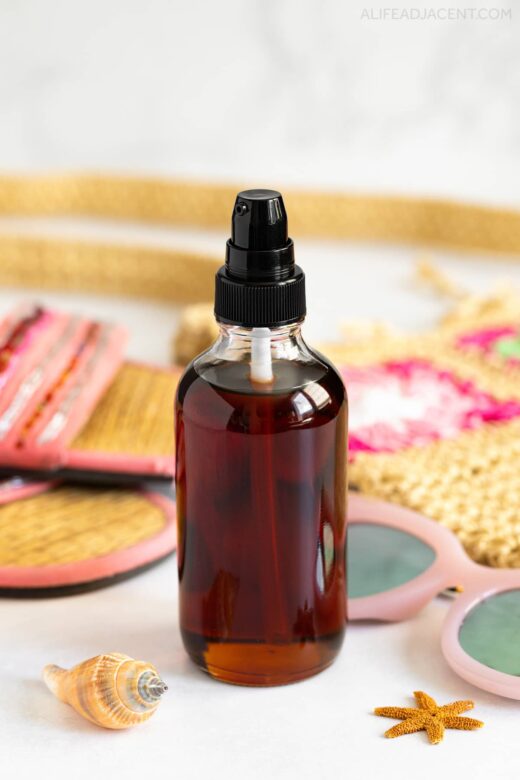
Recipe Notes
- This recipe makes 100g tanning oil, so you’ll need a 4oz dark glass pump bottle.
- You’ll need two 5ml bottles or one 10ml bottle of high quality coffee essential oil to equal 10g.
- For best results, use your suntan oil within a year. You can save any leftover for next summer, as the ingredients have a long shelf life.
Natural tanning oil ingredients + benefits
Fractionated coconut oil or MCT oil
Coconut oil has gained a reputation as one of the best natural tanning oils, and for good reason. It’s almost completely saturated, which makes it highly stable and good for both cooking and tanning.
If you’re pressed for time, you can always take a jar of virgin coconut oil to the beach! However, you can make an even better tanning oil by using fractionated liquid coconut oil (or MCT oil).
What makes fractionated coconut oil best for tanning? Essentially, it’s coconut oil that’s been refined into only the liquid fractions of capric acid and caprylic acid. This gives it a very light, non-greasy “dry oil” texture, so it’s perfect for those who usually prefer a tanning oil without coconut oil to avoid greasiness.
Liquid coconut oil also has the added benefit of a very long shelf life – some sources say it lasts indefinitely. In any case, fractionated coconut oil has very high oxidative stability that can withstand your tanning session.
Liquid lanolin
Lanolin helps moisturize and protect skin against the sun’s harsh rays while increasing your ability to tan faster and darker.
A highly effective moisturizer and emollient, lanolin is well known for softening dry, rough skin. It’s comprised of a complex mixture of wax esters, sterols, and mostly saturated fatty acids, which makes it highly nourishing, protective, and low-PUFA.
(Lanolin is also cruelty free – it’s harvested from sheared sheep wool, so no animals are harmed.)
What does this have to do with tanning oil? Lanolin is rich in natural cholesterol, which is essential for a healthy skin barrier and bouncy, youthful skin.
We lose skin cholesterol as we age, which not only contributes to dry, crepey skin, but it also reduces the skin’s ability to synthesize vitamin D – and vitamin D is vital for tanning (more on this later).
Does lanolin make tanning oil greasy?
You might know lanolin as a thick, greasy ointment, but we’ll be using lanolin oil instead, which is refined to leave lanolin’s liquid fractions only.
Liquid lanolin is a lot less greasy than pure lanolin, especially when it’s diluted with non-greasy fractionated coconut oil. Once you see how moisturized and protected your skin feels, you’ll understand why lanolin makes an excellent body oil!
It adds a slight viscosity that ensures your tanning oil won’t just rub off onto your beach towel. Plus, lanolin oil is slightly water resistant and sweat-proof, too.
What if I’m allergic to lanolin?
If you’re allergic to lanolin, you have a couple options. First, determine whether it’s a true lanolin allergy, or a sensitivity to certain impurities – studies have shown that allergic reactions to lanolin are reduced by purifying the product 13.
For instance, I’m sensitive to many lanolin products. But I can use ultra-purified lanolin with no reaction whatsoever, such as Lanolips 101 Ointment. If this is the case for you, simply replace the lanolin oil in the recipe with purified lanolin.
If you’re truly allergic, you can omit the lanolin in favor of fractionated coconut oil. But you may need to reapply your tanning oil more often, as coconut oil disappears into skin and rubs off more easily.
Coffee essential oil
This DIY tanning oil gets its rich, dark bronze color and heavenly natural fragrance from coffee essential oil.
But despite its name, coffee oil is cold-pressed from roasted coffee beans, which makes it a carrier oil, not an essential oil. As such, it’s not subject to the same maximum usage rates as true essential oils.
(But it’s still important to buy it from a reputable source, as coffee oil is a prime target for being diluted or adulterated.)

Coffee oil serves a few key purposes in this recipe: natural color and fragrance, sun protection, antioxidant properties, and insect repellent.
Because of its deep color, applying coffee oil gives you somewhat of an “instant tan,” similar to the baby oil iodine trick that’s used to stain the skin. For this reason, coffee is often used as a natural self-tanner.
There’s something fun about using a tanning oil that looks like it’s working immediately (just don’t wear your nicest white bikini to avoid stains). But aside from its aesthetic appeal, coffee oil also offers many skin benefits.
Coffee melanoidins for SPF
Firstly, coffee bean oil is rich in melanoidins, natural brown pigments that give roasted coffee beans their rich, dark color.
Named for their melanin-mimicking properties, melanoidins are byproducts of the Maillard browning reaction, which is the same reaction used to self-tan the skin.
While not a replacement for SPF, coffee melanoidins have been shown to absorb UV light14,15, offering a small amount of natural sun protection16. In fact, coffee oils have been tested as natural sunscreens in more than one study17.
The effect in this recipe is likely negligible (and please note that coffee oil won’t prevent sunburn), but it can’t hurt to add a small amount of SPF to your tanning oil.
Coffee antioxidants for skin protection
Aside from their color, coffee melanoidins also have antioxidant properties that may help protect your skin against oxidative damage while you tan18.
Coffee oil is also incredibly high in other antioxidants as well, such as caffeine, which can also enhance skin firmness and tone.
Repel bugs while tanning
The scent of coffee oil repels bugs, which is great if you’re used to being dive bombed by wasps and other critters in your backyard. When I use a homemade tanning oil with coffee oil, bugs actually leave me alone!
Applying essential oils to your skin can be dangerous while tanning, so they should not be used in a suntan oil. That’s because essential oils break down rapidly under direct sunlight19, creating oxidation products which can damage the skin and make sunburn more likely.
Even seemingly innocuous oils such as lavender, citrus and peppermint do not belong in a tanning oil.
Does coffee oil contain PUFAs?
Some varieties of coffee oil are high in PUFAs, which may seem contrary to what I’ve discussed here.
I believe the small amount of coffee oil used in this tanning oil offers benefits that outweigh its PUFA content. The saturated fats and antioxidants in this recipe also stabilize the formula.
If you want to avoid PUFAs completely, you could also naturally color your suntan oil by using a small amount of Kombo butter instead.
Vitamin E
Topically applied vitamin E improves sun damage and protects against lipid peroxidation20, making it one of the best tanning oil ingredients.
In fact, its main purpose it to stabilize fatty acids in our skin and cell membranes (especially PUFAs). This means vitamin E is one of the first lines of defence against sunburn and UV-induced skin damage.
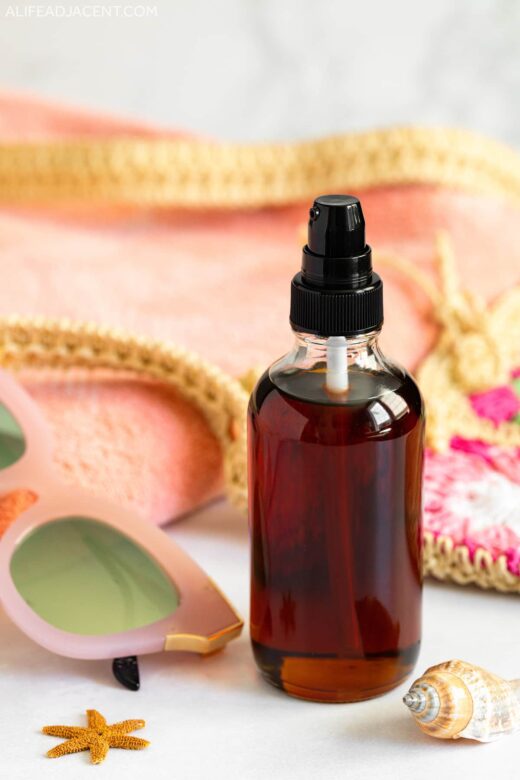
PUFAs and vitamin E have an interdependent relationship – vitamin E protects PUFAs, but excess PUFA also consumes vitamin E21. So it’s important to have enough vitamin E in your skin, especially during sun exposure.
In terms of sun protection, vitamin E absorbs some UVB light22, but please note that it does not replace a broad-spectrum sunscreen.
I scoured the internet to find pure vitamin E oil without PUFAs, as it often contains residual soybean or sunflower oil leftover from the refining process. I use vitamin E from Forefront Health, which is PUFA free.
If that’s not accessible to you, your best bet is to look for dark-colored, pure mixed tocopherols with no added fillers, sometimes labelled as T-50 tocopherols.
Tetrahexyldecyl Ascorbate (Vitamin C)
Vitamin C is well known for its role in collagen synthesis as well as its antioxidant, DNA-protective, and anti-aging properties. Like vitamin E, it also helps prevent sun-induced lipid peroxidation23, which is valuable while tanning.
However, studies have found that vitamin E and vitamin C are more effective for UV protection when combined24. They work synergistically, “recharging” the other for even more antioxidant power.
This tanning oil recipe contains oil-soluble vitamin C in the form of tetrahexyldecyl ascorbate (THD ascorbate). Unlike L-ascorbic acid or other forms of vitamin C, tetrahexyldecyl ascorbate is easy to use and incorporate into oil-based skincare products. It’s also highly stable, so it won’t oxidize or turn orange like some forms of vitamin C.
Not only that, but it may also be more potent than ascorbic acid for stimulating collagen synthesis25. Plus, it’s more effective at protecting the skin against both UVA and UVB26,27.
Tetrahexyldecyl ascorbate is a specialty ingredient that may not be accessible to everyone, so it’s optional, and your homemade tanning oil will still be effective without it. You can find it at cosmetic supply stores and it’s also often available on Etsy.
Vitamin D
Did you know that you need vitamin D to tan? Vitamin D is implicated in skin pigmentation, and without it, you cannot synthesize the melanin that causes your skin to darken28.
The key is to combine vitamin D with sun exposure, which is why it’s such an effective addition to a suntan oil.
Vitamin D and sunlight promote the melanocyte proliferation (melanin-producing cells), and stimulate melanogenesis (the process of making more melanin)29. In fact, vitamin D and UV light are used to restore skin color in people with vitiligo.
But it goes further than that – vitamin D may also help offer skin protection from UV damage30, making it even more important to have adequate levels.
I use Thorne vitamin D drops in my bronzing oil. You can use any kind of vitamin D drops you have, but I recommend using products with low-PUFA oils such as olive oil or MCT oil, not sunflower oil.
It’s important to remember that vitamin D is a hormone, and excessive levels can be dangerous. As a reminder, please be sure to read the safety disclaimer.
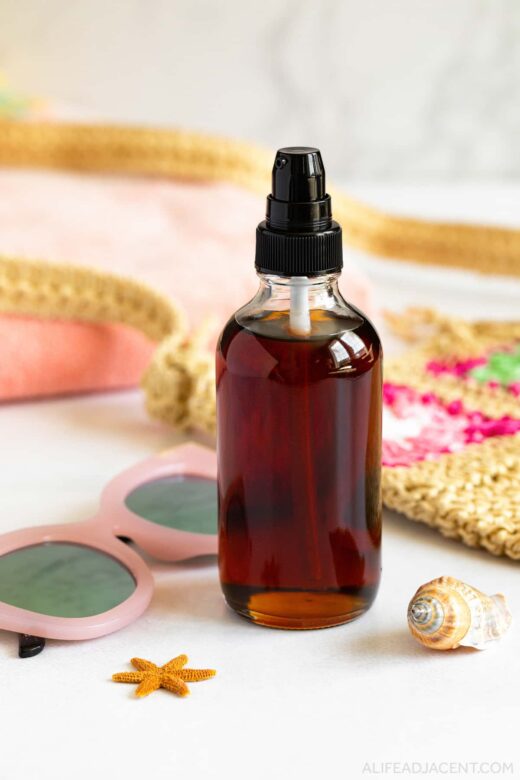

Natural DIY Tanning Oil Recipe
Make this DIY tanning oil for a natural, sun-kissed glow! Skip the baby oil or chemical-laden bronzing lotions. Learn how to make all natural tanning oil with low-PUFA carrier oils, sun-protective antioxidants, and a tanning accelerator to help you achieve a dark tan fast.
Materials
DIY Tanning Oil
- 65g fractionated coconut oil or MCT oil
- 20g liquid lanolin or ultra-purified lanolin
- 10g coffee essential oil
- 2g vitamin E oil
- 56,000 IU / 112 drops vitamin D
- 0.2g tetrahexyldecyl ascorbate
3-Ingredient Tanning Oil
Instructions
- Mix carrier oils. Using a cosmetic scale, weigh fractionated coconut oil, liquid lanolin, and coffee oil into a glass lab beaker (alternatively, you can also mix your ingredients directly into your tanning oil bottle). Mix or whisk well to combine.
- Measure tanning actives. In a small, separate container or lab beaker, carefully weigh the active ingredients: vitamin E oil, vitamin C, and vitamin D. (Since these ingredients are used in such small amounts, using a separate container ensures you can measure carefully and precisely.)
- Mix oils + actives. Pour the active ingredients into the carrier oils and mix well to combine. (If you made your tanning oil in your pump bottle, simply replace the lid and shake well to combine all ingredients.)
- Transfer to bottle. Transfer the oil to a glass pump bottle for easy use – preferably cobalt or amber glass, as dark colored bottles help protect the fragile ingredients from the harsh sunlight outside. You can also place it in a spray bottle if you'd prefer a sun tanning oil spray.
- Finished. Your natural tanning oil is ready to use. Apply evenly to your body on clean, dry skin and enjoy your tanning session. If you have not already established a base tan, be sure to follow with a non-toxic sunscreen to prevent sunburn.
Notes
- This recipe makes 100g tanning oil, so you'll need a 4oz dark glass pump bottle.
- You'll need two 5ml bottles or one 10ml bottle of high quality coffee essential oil to equal 10g.
- For best results, use your suntan oil within 1 year. You can save any leftover for the next summer, as the ingredients have a long shelf life.
Recommended Products
As an Amazon Associate and member of other affiliate programs, we earn from qualifying purchases.
📌 Pin it for later

⚠️ Tanning oil safety disclaimer
Tanning is a controversial subject, and for good reason. To be clear, I am not suggesting tanning is safe, and I am not encouraging anyone to tan, either. This post is only for those who are aware of the risks and choose to tan anyway.
You make and use this DIY tanning oil at your own risk. It’s your own personal responsibility to use suntan oil responsibly, take precautions against sunburn, and ensure you do not get too much sun exposure.
When I use phrases such as “protects your skin,” I’m not inferring this natural tanning oil will prevent all skin damage or completely protect you from sunburn.
You know your skin better than anyone. Please start slow, use sunscreen, and go inside at the first sign of redness. As a reminder, please note that tanning oil is best used once you already have a base tan, as melanized skin has natural sun protection.
Additionally, this recipe has not been evaluated by any medical professional. I’m not a doctor or a dermatologist, and none of the claims on this blog are meant to be taken as medical advice. This blog post contains my personal opinion based on my own testing, research, and personal experience.
Vitamin D safety disclaimer
This tanning oil recipe contains 56,000 IU vitamin D. Even if you were to use the entire bottle in a week (highly unlikely) and absorb up to 50% of the vitamin D applied to your skin (likely impossible, given its low absorption rate31) you’d receive only 28,000 IU a week. This is the equivalent of taking the tolerable upper limit for vitamin D daily (4000 IU32).
While evidence suggests vitamin D is not readily absorbed through the skin, your results may vary. I’ve done my best to ensure vitamin D is used at a non-toxic level, but I’m not a doctor.
Vitamin D overdose can be dangerous, so you should consult your doctor to make sure this recipe is safe for you, especially if you have any medical conditions.
- Mead, M Nathaniel. “Benefits of sunlight: a bright spot for human health.” Environmental health perspectives vol. 116,4 (2008): A160-7. doi:10.1289/ehp.116-a160
- Alfredsson, Lars et al. “Insufficient Sun Exposure Has Become a Real Public Health Problem.” International journal of environmental research and public health vol. 17,14 5014. 13 Jul. 2020, doi:10.3390/ijerph17145014
- Krause, M et al. “Sunscreens: are they beneficial for health? An overview of endocrine disrupting properties of UV-filters.” International journal of andrology vol. 35,3 (2012): 424-36. doi:10.1111/j.1365-2605.2012.01280.x
- Perer, Jessica et al. “The sunless tanning agent dihydroxyacetone induces stress response gene expression and signaling in cultured human keratinocytes and reconstructed epidermis.” Redox biology vol. 36 (2020): 101594. doi:10.1016/j.redox.2020.101594
- Gallagher, Mary. “Exposure to dihydroxyacetone in sunless tanning products.” Journal of the Dermatology Nurses’ Association, vol. 10, no. 1, 2018, pp. 11–17, https://doi.org/10.1097/jdn.0000000000000366.
- Armas, Laura A G et al. “Do melanoidins induced by topical 9% dihydroxyacetone sunless tanning spray inhibit vitamin d production? A pilot study.” Photochemistry and photobiology vol. 85,5 (2009): 1265-6. doi:10.1111/j.1751-1097.2009.00574.x
- Sparks, Robert. “What Is the Refractive Index of Oil? Understanding It Thoroughly.” Optics Mag, 26 Jan. 2023, opticsmag.com/what-is-the-refractive-index-of-oil/.
- Postaire, E et al. “Evidence for antioxidant nutrients-induced pigmentation in skin: results of a clinical trial.” Biochemistry and molecular biology international vol. 42,5 (1997): 1023-33. doi:10.1080/15216549700203481
- Assi, Ali, et al. “Characterization of free fatty acids photo‐oxidation under UV radiations: A Stepwise Raman study.” Journal of Raman Spectroscopy, vol. 54, no. 1, 2022, pp. 24–36, https://doi.org/10.1002/jrs.6449.
- Peat, Raymond. “Using Sunlight to Sustain Life.” Townsend Letter for Doctors & Patients, no. 155, June 1996, pp. 83–85.
- Zingg, Jean-Marc, and Mohsen Meydani. “Interaction between vitamin E and polyunsaturated fatty acids.” Vitamin E in Human Health, 2019, pp. 141–159, https://doi.org/10.1007/978-3-030-05315-4_11.
- Shanahan, Catherine, and Luke Shanahan. “The Sun Can Damage Skin, But It Doesn’t Have To.” Deep Nutrition: Why Your Genes Need Traditional Food, Flatiron Books, New York, 2018.
- Kligman, A M. “The myth of lanolin allergy.” Contact dermatitis vol. 39,3 (1998): 103-7. doi:10.1111/j.1600-0536.1998.tb05856.x
- Choi, Hyeon-Son et al. “Topical application of spent coffee ground extracts protects skin from ultraviolet B-induced photoaging in hairless mice.” Photochemical & photobiological sciences : Official journal of the European Photochemistry Association and the European Society for Photobiology vol. 15,6 (2016): 779-90. doi:10.1039/c6pp00045b
- Portillo, Ostilio R., and Ana C. Arévalo. “Coffee’s melanoidins. A critical review of contemporary scientific literature.” Bionatura, vol. 7, no. 3, 2022, pp. 1–10, https://doi.org/10.21931/rb/2022.07.03.4.
- Melanoidins as an Adjuvant for Sun Protection in 5 Siblings with Bloom Syndrome, www.wcd2019milan-dl.org/abstract-book/documents/abstracts/31-photobiology-photoprotection/melanoidins-as-an-adjuvant-for-4892.pdf. Accessed 27 Aug. 2023.
- Marto, J., et al. “The green generation of sunscreens: Using coffee industrial sub-products.” Industrial Crops and Products, vol. 80, 2016, pp. 93–100, https://doi.org/10.1016/j.indcrop.2015.11.033.
- Iriondo-DeHond, Amaia, et al. “Antioxidant properties of high molecular weight compounds from coffee roasting and brewing byproducts.” Bioactive Compounds in Health and Disease, vol. 2, no. 3, 2019, p. 48, https://doi.org/10.31989/bchd.v2i3.588.
- Tisserand, Robert, et al. Essential Oil Safety: A Guide for Health Care Professionals. Churchill Livingstone/Elsevier, 2014.
- Rinnerthaler, Mark et al. “Oxidative stress in aging human skin.” Biomolecules vol. 5,2 545-89. 21 Apr. 2015, doi:10.3390/biom5020545
- Zingg, Jean-Marc, and Mohsen Meydani. “Interaction between vitamin E and polyunsaturated fatty acids.” Vitamin E in Human Health, 2019, pp. 141–159, https://doi.org/10.1007/978-3-030-05315-4_11.
- Maalouf, Samar et al. “Protective effect of vitamin E on ultraviolet B light-induced damage in keratinocytes.” Molecular carcinogenesis vol. 34,3 (2002): 121-30. doi:10.1002/mc.10055
- Krajcovicová-Kudlácková, M et al. “Lipid peroxidation in relation to vitamin C and vitamin E levels.” Central European journal of public health vol. 12,1 (2004): 46-8.
- Eberlein-König, B et al. “Protective effect against sunburn of combined systemic ascorbic acid (vitamin C) and d-alpha-tocopherol (vitamin E).” Journal of the American Academy of Dermatology vol. 38,1 (1998): 45-8. doi:10.1016/s0190-9622(98)70537-7
- BV-OSC (TETRAHEXYLDECYL ASCORBATE) DOSSIER, Barnet Products Corporation, cdn.shopify.com/s/files/1/0319/8073/files/BV-OSC_TETRAHEXYLDECYL_ASCORBATE.pdf. Accessed 27 Aug. 2023.
- Xiao, Li et al. “Cytoprotective effects of the lipoidic-liquiform pro-vitamin C tetra-isopalmitoyl-ascorbate (VC-IP) against ultraviolet-A ray-induced injuries in human skin cells together with collagen retention, MMP inhibition and p53 gene repression.” Journal of cellular biochemistry vol. 106,4 (2009): 589-98. doi:10.1002/jcb.22032
- Ochiai, Yasunobu et al. “A new lipophilic pro-vitamin C, tetra-isopalmitoyl ascorbic acid (VC-IP), prevents UV-induced skin pigmentation through its anti-oxidative properties.” Journal of dermatological science vol. 44,1 (2006): 37-44. doi:10.1016/j.jdermsci.2006.07.001
- AlGhamdi, Khalid, et al. “The role of vitamin D in melanogenesis with an emphasis on Vitiligo.” Indian Journal of Dermatology, Venereology, and Leprology, vol. 79, no. 6, 2013, p. 750, https://doi.org/10.4103/0378-6323.120720.
- Xu QX, Du J, He PY, Zhang JZ, Zhu TJ. [Effects of 1alpha,25-dihydroxyvitamin D(3) and UVB on cell proliferation and melanin synthesis of cultured human melanocyte]. Beijing da xue xue bao. Yi xue ban = Journal of Peking University. Health Sciences. 2004 Oct;36(5):483-486. PMID: 15489927.
- Feldman, David, et al. Vitamin D (Third Edition), Volume II. Academic Press, 2011.
- Wyon, M.A., et al. “The efficacy of different vitamin D supplementation delivery methods on serum 25(OH)d: A randomised double-blind placebo trial.” Clinical Nutrition, vol. 40, no. 2, 2021, pp. 388–393, https://doi.org/10.1016/j.clnu.2020.05.040.
- “Vitamin D.” The Nutrition Source, 7 Mar. 2023, www.hsph.harvard.edu/nutritionsource/vitamin-d/.



